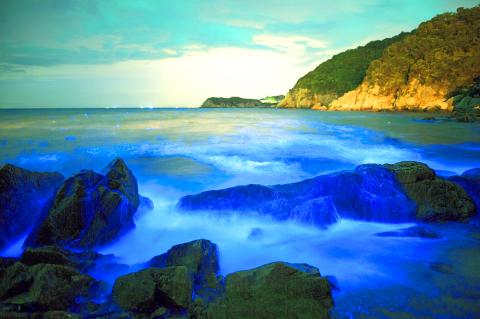Fluorescent sea sparkles, dubbed “blue tears,” that glow around the Matsu Islands of Lienchiang County are not caused by toxic algae and are not a sign of environmental deterioration, a National Taiwan Ocean University professor said on Sunday, challenging a recent study.
Chiang Kuo-ping (蔣國平) said that it cannot be established that the “blue tears” along Matsu’s beaches are associated with toxic algae because they do not drain oxygen from the surrounding waters and kill marine life in the process as stated in the study.
He said the single-celled Noctiluca scintillans, also known as dinoflagellates or sea sparkles, that generate the bioluminescence described as blue tears when disturbed, are non-toxic heterotrophs — organisms that cannot produce their own nutrients.

Photo courtesy of the Lienchiang County Government
In coastal ecosystems, they replace copepods — small crustaceans commonly found in aquatic communities — as the main consumers of phytoplankton and play the role of a “terminator” of single-cell algae called diatoms, which Chiang described as a normal phenomenon in marine ecosystems.
The toxic algae argument does not hold water along the coastlines of the Matsu Islands because the sea sparkles have not starved the water of oxygen or led to the death of marine life, he said.
The US study in the journal Geophysical Research Letters was conducted by people with expertise in studying satellite data and images rather by than ecological experts, he said.
The study by Hu Chuanmin, a professor of optical oceanography at the University of South Florida, was extensively covered by local media.
It argued that sea sparkles have become more abundant in recent years based on satellite images that have tracked their movement.
The study observed that from 2000 to 2003 when the Three Gorges Dam was being built on the Yangtze River and there was little water flow, there was only a small distribution of blue tears, but since construction had been completed and the water flow was restored to normal, the blue tears had steadily expanded.
While the reason for that cannot be determined for certain at present, it is likely related to the major release of pollution and agricultural runoff of nutrients from the Yangtze River into the East China Sea, the study said.
Explaining the study to the Live Science Web site, Hu said the sea sparkles are not toxic themselves, but when they eat, they usually choose toxic algae and in the process release ammonia and other chemicals that poison the water around them.
They also breathe oxygen until there is none left in the surrounding waters, making their growing numbers particularly troublesome, Hu was cited as saying by Live Science.
“The oxygen in the water is so low that many animals die,” he was quoted as saying.

The brilliant blue waters, thick foliage and bucolic atmosphere on this seemingly idyllic archipelago deep in the Pacific Ocean belie the key role it now plays in a titanic geopolitical struggle. Palau is again on the front line as China, and the US and its allies prepare their forces in an intensifying contest for control over the Asia-Pacific region. The democratic nation of just 17,000 people hosts US-controlled airstrips and soon-to-be-completed radar installations that the US military describes as “critical” to monitoring vast swathes of water and airspace. It is also a key piece of the second island chain, a string of

A magnitude 5.9 earthquake that struck about 33km off the coast of Hualien City was the "main shock" in a series of quakes in the area, with aftershocks expected over the next three days, the Central Weather Administration (CWA) said yesterday. Prior to the magnitude 5.9 quake shaking most of Taiwan at 6:53pm yesterday, six other earthquakes stronger than a magnitude of 4, starting with a magnitude 5.5 quake at 6:09pm, occurred in the area. CWA Seismological Center Director Wu Chien-fu (吳健富) confirmed that the quakes were all part of the same series and that the magnitude 5.5 temblor was

The Central Weather Administration has issued a heat alert for southeastern Taiwan, warning of temperatures as high as 36°C today, while alerting some coastal areas of strong winds later in the day. Kaohsiung’s Neimen District (內門) and Pingtung County’s Neipu Township (內埔) are under an orange heat alert, which warns of temperatures as high as 36°C for three consecutive days, the CWA said, citing southwest winds. The heat would also extend to Tainan’s Nansi (楠西) and Yujing (玉井) districts, as well as Pingtung’s Gaoshu (高樹), Yanpu (鹽埔) and Majia (瑪家) townships, it said, forecasting highs of up to 36°C in those areas

IN FULL SWING: Recall drives against lawmakers in Hualien, Taoyuan and Hsinchu have reached the second-stage threshold, the campaigners said Campaigners in a recall petition against Chinese Nationalist Party (KMT) Legislator Yen Kuan-heng (顏寬恒) in Taichung yesterday said their signature target is within sight, and that they need a big push to collect about 500 more signatures from locals to reach the second-stage threshold. Recall campaigns against KMT lawmakers Johnny Chiang (江啟臣), Yang Chiung-ying (楊瓊瓔) and Lo Ting-wei (羅廷瑋) are also close to the 10 percent threshold, and campaigners are mounting a final push this week. They need about 800 signatures against Chiang and about 2,000 against Yang. Campaigners seeking to recall Lo said they had reached the threshold figure over the